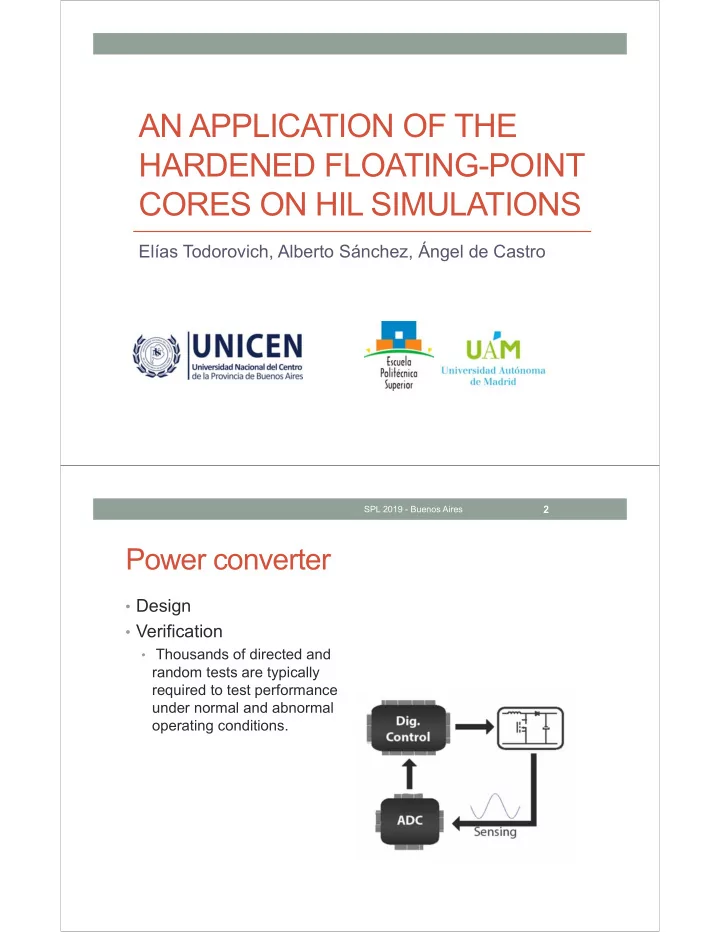

AN APPLICATION OF THE HARDENED FLOATING-POINT CORES ON HIL SIMULATIONS Elías Todorovich, Alberto Sánchez, Ángel de Castro SPL 2019 - Buenos Aires 2 Power converter • Design • Verification • Thousands of directed and random tests are typically required to test performance under normal and abnormal operating conditions.
3 SPL 2019 - Buenos Aires HIL emulation • For HIL applications, the controller is connected to a virtual plant executed on a real-time simulator, instead of to a physical plant. SPL 2019 - Buenos Aires 4 Our goal… • Is to develop a HIL converter model. • That is a verification device • AKA Verification IP • … an accurate model for HIGH-speed applications!
5 SPL 2019 - Buenos Aires Power electronic applications • Accurately simulating fast-switching power electronic devices requires the use of very small time-steps to solve system equations SPL 2019 - Buenos Aires 6 Fast-switching power electronic apps. • For example, the switching frequency is 40 MHz in • M. Rodríguez, Y. Zhang, and D. Maksimovic. High-frequency PWM buck converters using GaN-on-SiC HEMTs. IEEE Transactions on Power Electronics, 29(5):2462–2473, May 2014. • And 75 MHz in • J. G. Kassakian and T. M. Jahns. Evolving and emerging applications of power electronics in systems. IEEE Journal of Emerging and Selected Topics in Power Electronics, 1(2):47–58, June 2013.
7 SPL 2019 - Buenos Aires Simulation step • At least 100 points per switching period are needed to obtain accurate enough results. • For example, a switching frequency is 100 kHz, requires an integration frequency of at least 10 MHz. • So… simulation time-step can be very short • An integration frequency of 10 MHz means an integration step of 100 ns. • 250 ns in: M. Matar and R. Iravani. FPGA implementation of the power electronic converter model for real-time simulation of electromagnetic transients. IEEE Transactions on Power Delivery, 25(2):852–860, April 2010. SPL 2019 - Buenos Aires 8 FPGAs came up to help • FPGAs have many advantages for real-time simulation and are successfully applied on HIL systems since 2010.
9 SPL 2019 - Buenos Aires But if floating-point is used… • But even using FPGAs, it has not been possible to reach real time simulations when small integration steps are necessary (around 100 ns or lower) if floating-point representation is used. SPL 2019 - Buenos Aires 10 Representation of variables in high- speed… • Floating-Point • Fixed-point • Area • Area • Performance • Performance • Design-time • Design-time Area, delay, and design time
11 SPL 2019 - Buenos Aires Hardened floating-point Area + Performance + Design time SPL 2019 - Buenos Aires 12 Study case • Topology of a full-bridge converter • An algorithm defines d and q based on S1 to S4 • The model needs to calculate the output voltage (Vout) and inductor current (iL) every time step, taking into account four configurations.
13 SPL 2019 - Buenos Aires Study case: converter equations • Output voltage for each • Inductor current when dq = time step k, regardless of 10, dq = 01, and dq = 11 or the configuration: dq = 00, respectively: SPL 2019 - Buenos Aires 14 Study case: implementation • Digital circuit • Four HFPs…
15 SPL 2019 - Buenos Aires Study case: verification • The evaluation is done by • Multiple simulations have been collecting the state variable performed: Input voltage values, and comparing those transients, changes on the duty- values with those of a reference cycle, load transients and also model. simulation of steady states. • The reference model in VHDL is based on variables of real type and an integration step of 1.25 ns. SPL 2019 - Buenos Aires 16 Study case: results
17 SPL 2019 - Buenos Aires Conclusions • We have focused on a verification artifact: HIL converter models. • Industry needs high-speed and accurate HIL models. • Hardened floating-point cores are as fast as fixed-point implementations with a better design time… • … but these HFP cores support single-precision IEEE 745 operations, with known accuracy issues. • The problem of using wider variables is that, if a non- standard floating-point format were used, the model would not take benefit of the HFP cores, unless a sort of hybrid technique might be developed in the future. AN APPLICATION OF THE HARDENED FLOATING-POINT CORES ON HIL SIMULATIONS Elías Todorovich, Alberto Sánchez, Ángel de Castro
Recommend
More recommend